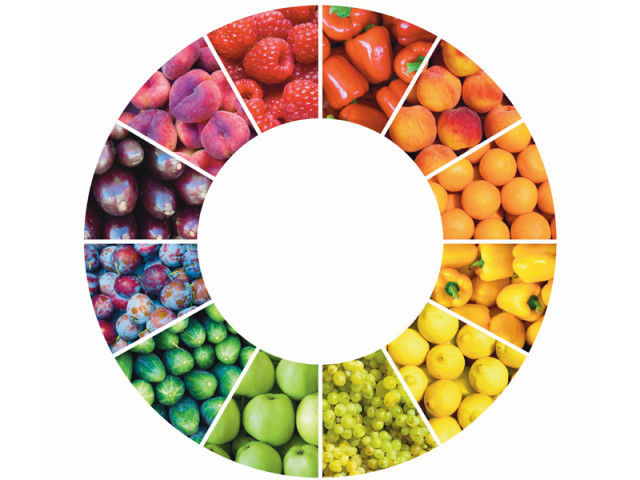The reason fruits and vegetables make you beautiful
Human beings have a super power and it’s called carotenoid ornamentation.

Human beings have a super power and it’s called carotenoid ornamentation. DESIGN: FAIZAN DAWOOD
Most of us at one time or the other have either heard or ourselves remarked that fruits and vegetables, with their vibrant colours, ‘look healthy.’ In fact, for some of us, on occasion that intuition alone has sufficed for us to be motivated to add some ‘veggies’ to our otherwise gooey, greasy meals.
Well, in the case that you belong in the above category, you can congratulate yourself for good intuition. As explained in a recent paper in the journal Evolutionary Psychology, Attractive Skin Coloration: Harnessing Sexual Selection to Improve Diet and Health, which comes from the School of Psychology at the University of St Andrews, the reason colourful fruits and vegetables look healthy is because they are the highest dietary sources of carotenoids.
What?
Carotenoids are pigments that occur in both plants and animals; in abundance, they appear on the surface of the latter in the form of a concentrated yellow-red hue. They not only give fruits and vegetables their characteristic vibrancy, but are also what give various species across the animal kingdom conspicuous physical traits, such as the strikingly orange beaks of blackbirds. This is what is known as ‘carotenoid ornamentation.’
The role of carotenoids
As explained by the author of the paper, Ross D Whitehead, carotenoids have two functions in the body: they, as aforementioned, act as skin pigments, and additionally act as ‘antioxidants.’ Antioxidants are substances that buffer the immune system to protect us (specifically our cells) from ‘oxidative stress’ ie damage resulting from environmental stressors.
Now, understandably, the antioxidant function takes priority. Thus, individuals who regularly experience ‘demand for cellular defence’ eg through infection or other illness, have a significant proportion of their expenditure of carotenoids directed at antioxidant function, consequently detracting from ornamentation.
The concept
According to the evolutionary psychology perspective, human beings evolved to perceive those traits as attractive that positively influence procreation, arguably the most powerful of which is health, a concept which we have become familiar with in the form of the slogan ‘health is beauty.’ Thus, carotenoid ornamentation is a primary marker of attractiveness because it serves as a reliable marker of the physical health of the host.
The recipe
Now, how does carotenoid ornamentation manifest in humans? In the form of a yellow-red glow of the skin. Whitehead demonstrates in his research that this quality in skin colour — the effect of which is that it optimises apparent healthiness — is appreciated by observers in individuals of all ethnicities, although it is most significant in the appearance of light-skinned Asians and Caucasians. As a matter of fact, the effect on attractiveness is much greater than that of tanning, which also involves changes in skin pigmentation.
The juice, served chilled
Whitehead doesn’t leave it up to us to figure out the details: The abundance of carotenoids in the skin is contingent on dietary intake of carotenoid and antioxidant-rich foods. As a matter of fact, the change is visible in as little as six weeks, and humans are so evolutionarily motivated at recognising skin carotenoid pigmentation that a mere two portions of fruits and vegetables per day leads to perceptible yellow-red ornamentation. Whitehead, though, leaves no room for guessing: with an experiment involving a computerised manipulation of skin colour against carotenoid consumption, he establishes that the optimal skin colour would materialise if an individual consumed 7.75 portions of fruits and vegetables per day.
There’s more good news. If you’re game, you don’t necessarily have to look up the nutritional profile of different fruits and vegetables to know what foods provide the highest carotenoid content — that successful intuition stemmed from the fact that we’re actually programmed to identify them. Even then, for the more competitive of us though who’re itching for a jump-start, here’s a list tailoured to our locale:
In fruit: papayas, apricots, mangoes, guavas and pink grapefruit.
In vegetables: sweet potatoes, tomatoes, carrots, turnips, spinach and red peppers.
So let the more well-informed of us borrow from salon-time and spend it in the kitchen this summer.
The author is the head of Scholars by Profession, a local research-initiative. Find out more at www.facebook.com/scholarsbyprofession
Published in The Express Tribune, March 18th, 2013.
Like Life & Style on Facebook for the latest in fashion, gossip and entertainment.



















COMMENTS
Comments are moderated and generally will be posted if they are on-topic and not abusive.
For more information, please see our Comments FAQ